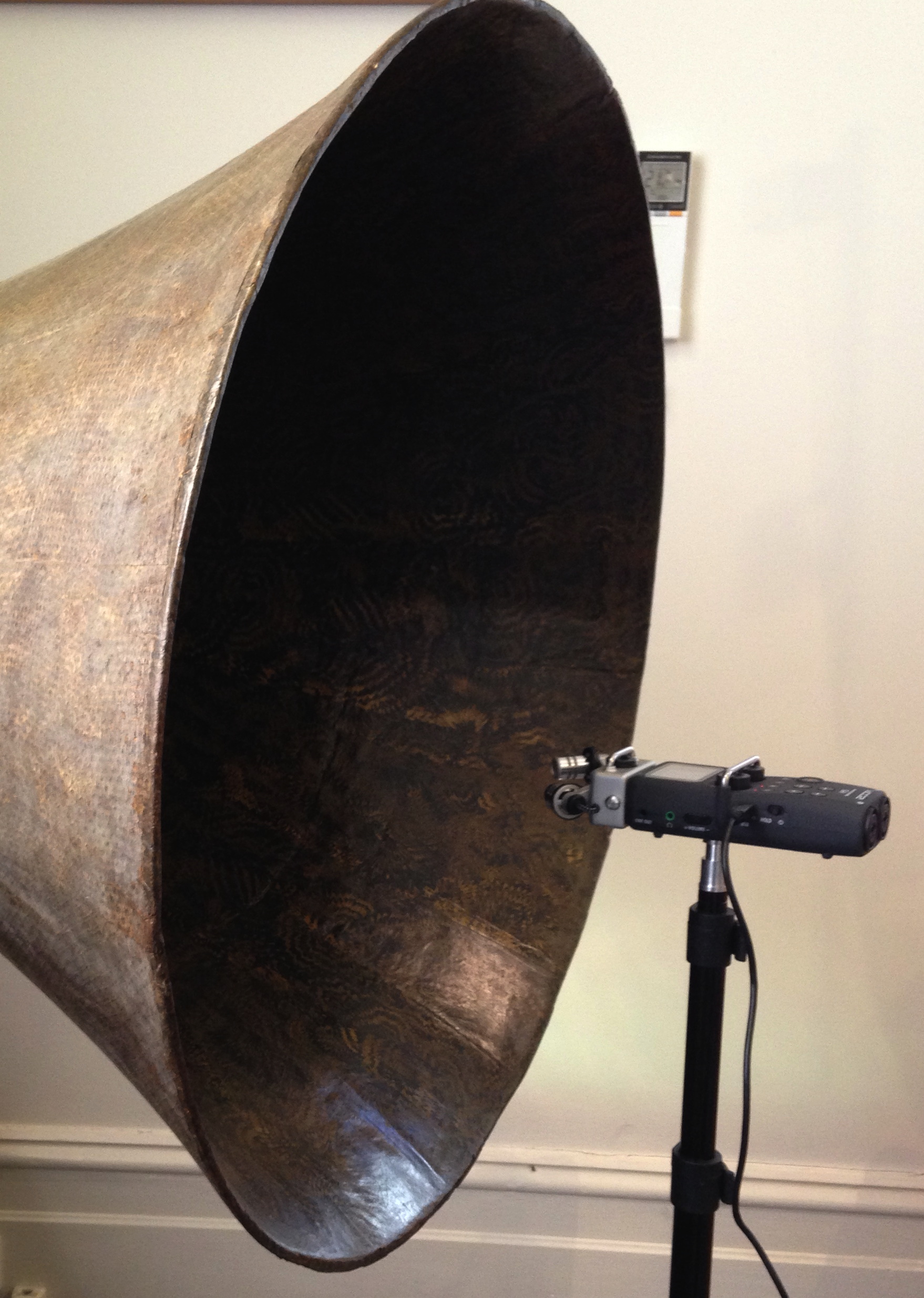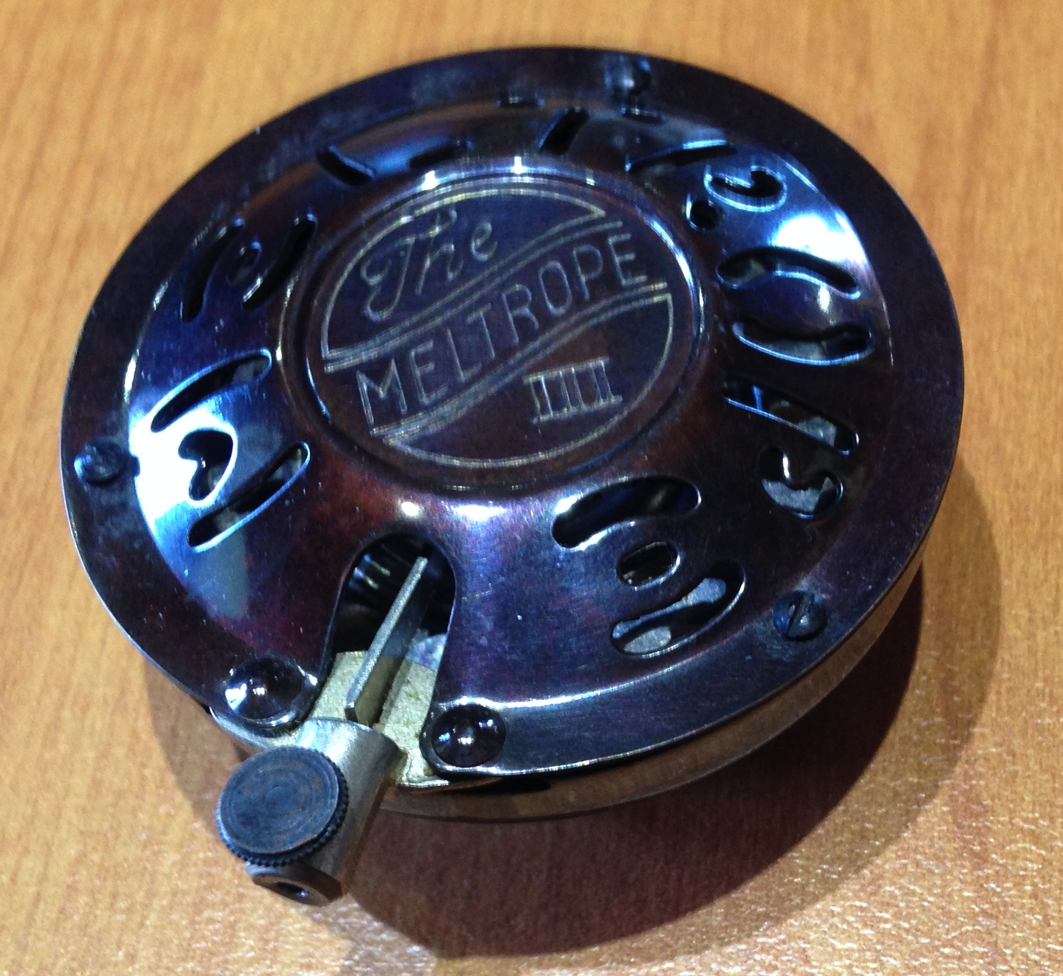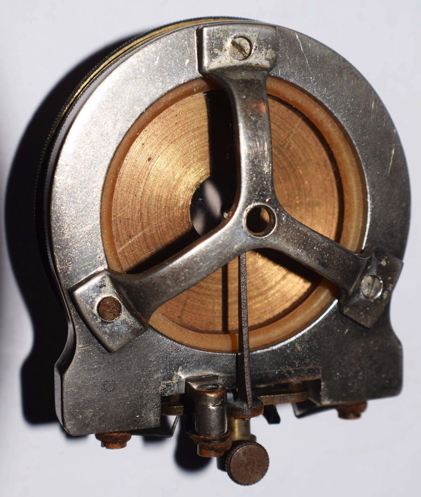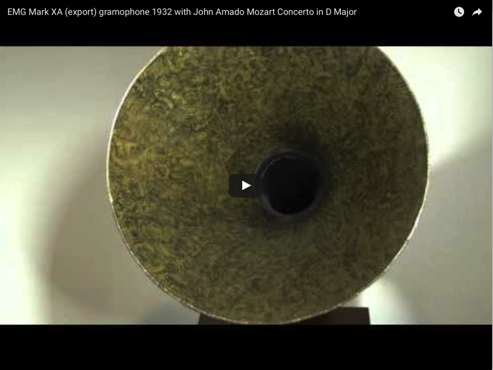« The 1932 EMG XA (Export) Gramophone | | Conservation of the Gramophone »
On this page… (hide)
1. Video demonstration of the EMG Xa (Export) Gramophone
John Amadio was a flautist of extraordinary virtuosity, with a technique of similar accomplishment to Sir James Galway widely regarded now at his peak as having risen to be the most technically adroit flautist in the world. Here we hear Amadio playing the glittering finale to Mozart’s Concerto in D, providing good insight into why the EMG gramophone was so well regarded in 1932, 4 years after this performance was recorded. This digital recording of the music was made using a Zoom H5 digital recording microphone placed on a stand close to and facing the centre of the outer rim of the EMG XA horn bell.

In order to show the gramophone in action, the sound was recorded first and then dubbed onto a video with the lid open. Of course the lid was closed to shut out surface noise while the sound was actually being recorded.
I would like to acknowledge the expertise of Martin Bartfeld and Annette Blonski in the videoing and production of this video.
NB. If the sound is played with good equipment and amplification the astute listener may detect a base click developing between 3.15 and 4.15 minutes. Unfortunately, after some 87 years of service, the record has developed a minor fault in those inner tracks. In many less fastidious circumstances the click is not audible. In addition, some slight wobble in the turntable platen was observed. This has now been rectified and a re-recording with that problem removed can be heard from the set of additional recordings presented below.
2. Comparison recordings from the gramophone.
As part of the process of turning what had been a curiosity into a functioning 1932 music centre I was lucky to acquire from friends some 60 early 78rpm records, which after washing turned out to be in surprisingly good condition, to which I added some purchases on-line. It was also interesting to compare the Mica diaphragm with the more common aluminium diaphragm and for this purpose acquired a Meltrope-III soundbox (in spectacularly good condition) from Chunny.1 (Thanks Chunny once again!). The Meltrope-III is shown below on the left, and the EMG 4-spring with mica on the right.
 |  |
The first set of recordings below show the different results from thorn and steel needles on the rebuilt EMG 4-spring soundbox, compared with the same configurations for the Meltrope-III soundbox.
2.1 John Amadio, Finale, Mozart Concerto in D Major, for Flute and Orchestra (recorded by His Masters Voice in 1928), on the EMG XA (Export) Gramophone with various soundboxes and styluses.
- with EMG 4-spring soundbox with mica diaphragm and thorn needle. Click here, to listen to this video
- with EMG 4-spring soundbox with mica diaphragm and steel needle (re-recorded with wobble in the turntable platen now rectified) Click here, to listen to this video
- with Meltrope-III soundbox with aluminium diaphragm and thorn needle. Click here, to listen to this video
- with Meltrope-III soundbox with aluminium diaphragm and steel needle. Click here, to listen to this video
3. Note
I have received a query as to whether, given the apparently extraordinarily fast rendition of this Mozart concerto by Amadio, the record was in fact being played too fast on the gramophone. As reassurance, I checked the speed of the turntable with a stroboscopic disk before playing the disk , and then, after recording, also checked the speed of the digital reproduction by checking the pitch. In particular I took bar 336 of the concerto, which in the score is a full bar (a minim in 2/4) of solo D natural, extracted it from the digital recording, put the extract into a repeating loop and tested it with a chromatic frequency meter app (“n-track tuner”) on an iPhone. The note clocks in as a D natural just as it should. It shows a tad sharp, and if I reduce the play speed in the digital recording to 0.99 (ie by 1%) (using Audacity software) a truer D is produced against the frequency standard. But 1% is a legitimate variation in concert pitch - even now, and certainly in 1928 - so as far as such a test can show, the record was being played at correct speed (as reported also by the strobe). I conclude that Amadio really played that fast (a bit faster even than the Galway recording I have listened to), perhaps because he was aiming to fit the piece onto one side of a 78 rpm record! Whatever his reason, and it could be because it just sounds so stunning, what a virtuoso player he was!!2
4. Other recordings from the gramophone.
Over time, more recordings will be added here.
1 See Conservation of the Gramophone for details of Chunny’s rebuild of the EMG soundbox (↑)
2 For more on the career and stunning virtuosity of John Amadio see Ann Cecil-Sterman, “John Amadio - Virtuoso Flutist” (↑)
« The 1932 EMG XA (Export) Gramophone | | Conservation of the Gramophone »
Pages linked to this page
 This work by Jim Falk is licensed under a Creative Commons Attribution-NonCommercial-NoDerivs 3.0 Unported License Click on the logo to the left to see the terms on which you can use it.
This work by Jim Falk is licensed under a Creative Commons Attribution-NonCommercial-NoDerivs 3.0 Unported License Click on the logo to the left to see the terms on which you can use it.
